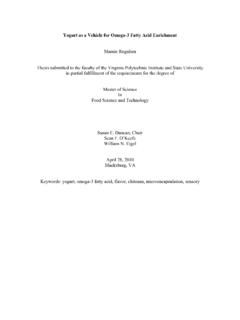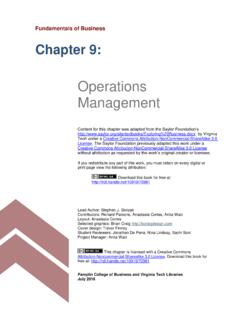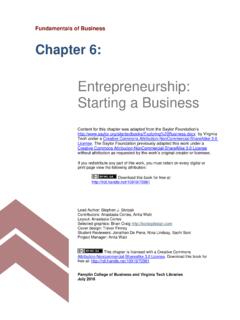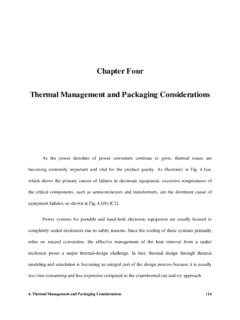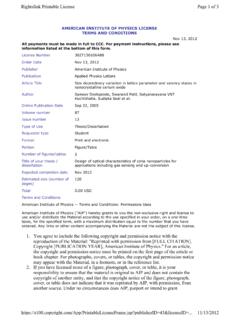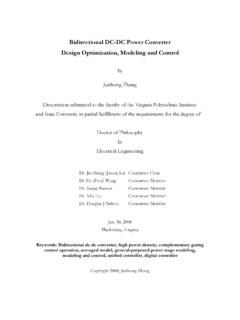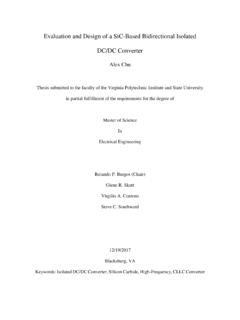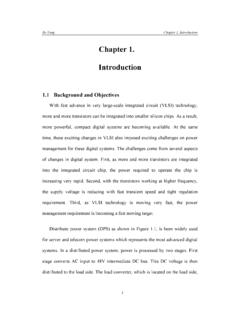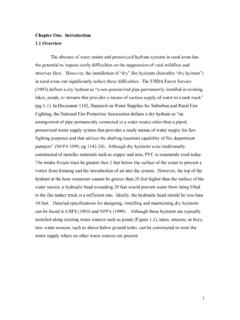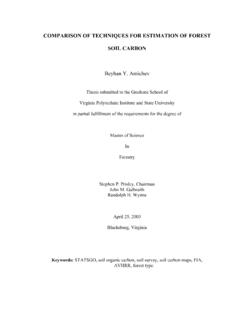Transcription of SOIL PARAMETERS - Virginia Tech
1 R. L. MokwaCHAPTER 5107 CHAPTER 5 soil INTRODUCTIONThe focus of the laboratory testing program was to develop soil PARAMETERS thatwill be used to perform analyses of the full-scale lateral load tests. The laboratory testsincluded soil classification, unit weight, strength (UU, CU, and CD triaxial tests), were performed on soil samples obtained from the field test facility (naturalsoils) and on samples of imported materials that were used as backfill around the piles,pile caps, and bulkhead. Section describes the results of tests on the natural soils,which consist of clayey and silty sands. Test results for the two backfill soils, crusher rungravel and New castle sand, are described in Section NATURAL soil DescriptionTest results for samples obtained at different depths are described according to theproject benchmark, which was established at an arbitrary elevation of feet. Theactual elevation of the benchmark is unknown, but judging from the USGS RadfordNorth quadrangle map, it is approximately 1700 feet above mean sea level.
2 The groundsurface in the area of the test foundations was relatively flat. The average surfaceelevation, after stripping the topsoil, was soil conditions at the site, which covers an area about 100 feet by 50 feet, arequite uniform. The soil profile revealed by six borings and two test pits was as follows:R. L. MokwaCHAPTER 5108 Elevation (ft) soil to silty sand and sandy lean clay withfine sands and frequent small to brown, moist sandy lean clay withoccasional to moist sandy silt with lenses of to , moist sandy silt and silty to brown sandy lean clay and sandy siltwith trace of general, the soils at the site consist of sandy clay, sandy silt, and silty sand withthin layers of gravel. In accordance with the Unified soil Classification System (ASTMD2487), the soils are classified as ML, CL, SC, and CL-ML. Chapter 4 contains adescription of the subsurface conditions encountered during the in situ Index Properties and Unit WeightsIndex tests were performed to provide data necessary for classifying the soil andfor developing correlations with various soil PARAMETERS .
3 The percentage of soil passingthe number 200 sieve, Atterberg limits, and natural moisture contents were determined ingeneral accordance with ASTM D1140, D4318, and D2216. Summaries of results fromthese tests are shown in Table and Figure unit weights of the natural soil were estimated from triaxial andconsolidation samples, and sand cone tests that were performed in the near-surface soilsin accordance with (ASTM D 1556). Most of the values of unit weight fall between 115and 125 pcf as shown in Figure (d).R. L. MokwaCHAPTER Consolidation TestsThree one-dimensional consolidation tests were performed in general accordancewith ASTM D2435, on specimens trimmed from undisturbed samples. Samples BH-4,ST-4, and BH-4 ST-5 were trimmed conventionally from undisturbed soil samples torepresent vertical consolidation properties of the soil . Sample BH-4, SST-3 was trimmedsuch that it represented horizontal consolidation properties of the soil . The testspecimens were loaded at twenty-four hour intervals using a load-increment ratio of one,and they were unloaded at twenty-four hour intervals using a load-increment ratio of curves from these tests are included in the Appendix D (Figure ), and thetest results are summarized in Table Strength TestsA total of 31 triaxial tests were performed on specimens trimmed fromundisturbed Shelby tube samples and block samples.
4 Of the 31 triaxial tests, 22 were UU(Unconsolidated-Undrained), 3 were CD (Consolidated-Drained), 3 were CU(Consolidated-Undrained), and 3 were staged CU tests. The UU specimens were testedat their natural moisture content. The CD and CU specimens were saturated by applyingback pressure. The CD, CU and 21 of the UU specimens were carved from Shelby tubesamples. These specimens were all trimmed to a nominal diameter of inches and anominal height of 3 of the UU specimens were carved from block samples. Four of these weretrimmed vertically and the remaining 6 were trimmed horizontally. Seven of thespecimens were trimmed to a nominal diameter of inches and a nominal height of 3inches. The other 3 specimens were trimmed vertically to a nominal diameter of and a nominal height of stress shear strength PARAMETERS . A summary of the UU triaxial results ispresented in Table Plots of p versus q at failure are shown in Figure (a) for testsperformed on samples obtained at 4 different elevations.
5 The same results are re-plottedR. L. MokwaCHAPTER 5110in Figure (b) as a function of q at failure and cell pressure. The undrained strengthparameters were estimated using the curves and transformation equations shown inFigure (b), with emphasis on values measured at cell pressures less than 7 psi. Thetotal stress PARAMETERS for the natural soils, determined in this manner, are as follows:Elevation (ft) (deg)c (psi) was no discernable difference in undrained behavior between the verticallyand horizontally trimmed specimens, or between the small diameter and large of 50, the strain required to mobilize 50 % of the soil strength, wereestimated from the triaxial stress strain curves. The estimated variation of 50 with depthis shown in Figure (f). The values increase with depth from about in the stiffupper crust to in the underlying softer soils. These are in good agreement withReese et al. s (1997) recommended 50 values of for stiff clay and for curves for the 10 UU tests performed on block sample specimens areincluded in Appendix B.
6 The confining pressure for these tests ranged from 0 to 4 of the initial tangent modulus, Ei, were estimated by transforming the stress-straindata using the hyperbolic formulation described by Duncan and Chang (1970). Thetransformation procedure is shown in Figures , , and for the natural soils. Theestimated values of Ei are shown in Figure (a). Ei does not vary significantly over therange of confining pressures that were used. Consequently, an average value of Ei =6,200 psi was selected for use in the L. MokwaCHAPTER 5111 Effective stress PARAMETERS . Summaries of the CU and CD test results arepresented in Tables and Plots of effective stress, p versus q, at failure for the CUand CD tests are shown in Figure No variation of effective strength PARAMETERS withdepth was apparent from the data. Values of and c determined from these tests are asfollows: (deg)c (psi)lower bound270best fit320upper BACKFILL soil Description and Index PropertiesTwo soil types were used as backfill in the lateral load tests: New Castle sand andcrusher run gravel.
7 These materials were selected because they are representative of thetypes of backfill materials often used for pile caps, footings, and other buried Castle sand. New Castle sand is a relatively clean, fine sand consistingpredominantly of subangular grains of quartz. Plots of 2 grain size distribution curves areshown in Figure About 70 % of the sand passes the No. 40 sieve and less than 1 %passes the No. 200 sieve. The coefficient of uniformity is , the coefficient ofcurvature is , and the Unified Classification is SP. The specific gravity of solids,determined in general accordance with ASTM D854, is The maximum andminimum densities determined in general accordance with ASTM D4253 and ASTMD4254 are 105 and pcf, run gravel. Crusher run gravel was obtained from the Sisson and RyanStone Quarry, located in Shawsville, Virginia . The material is produced by processingand screening quartz and limestone rock to produce a well-graded mixture containingR. L.
8 MokwaCHAPTER 5112angular to subangular grains that range in size from -inch gravel to silt-size gravel is produced to meet the requirements of VDOT Road and BridgeSpecification Section 205, Crusher Run Aggregate. The material obtained for this projectalso meets the more stringent gradation requirements of VDOT Road and BridgeSpecification Section 208, 21B-Subbase and Base of 4 grain size distribution curves are shown in Figure Approximately40 to 50 % of the material passes the No. 4 sieve, 10 to 20 % passes the No. 40 sieve, and5 to 10 % passes the No. 200 sieve. The soil passing the No. 200 sieve classifies asnonplastic silt, ML. The coefficient of uniformity is 23, the coefficient of curvature , and the Unified Classification for the crusher run aggregate ranges between a GW-GM and a SW-SM. This material is referred to as gravel or crusher run gravel in Standard Density RelationshipsNew Castle sand. Moisture-density relationships were determined for the NewCastle sand using the modified Proctor procedure (ASTM D1557).
9 The maximum dryunit weight was found to be 107 pcf at an optimum water content of 12 %. Themaximum and minimum densities determined in general accordance with ASTM D4253and ASTM D4254 are 105 and pcf, run gravel. CD triaxial tests were performed using crusher run gravelthat was scalped on the -inch sieve size. The grain size distribution curve for thescalped gravel is shown in Figure Density tests were performed on unscalped andscalped samples to provide a means of correlating field (unscalped) densities with lab(scalped) densities, as shown in Figure maximum dry densities were determined using the wet method, Method dry method, Method 1A, did not yield realistic results because of bulking andsegregation of the material during placement into the mold. The minimum dry densitieswere determined by pouring soil into the mold using a hand scoop (Method A) and byR. L. MokwaCHAPTER 5113filling the mold by extracting a soil filled tube (Method B). The results were essentiallythe same, and an average value was used.
10 Based on these results, Figure wasdeveloped to correlate density values measured in the field on unscalped material withdensity values measured in the lab on scalped material. The line shown in Figure canbe represented by the following equation:Drs = Drs is the relative density of the scalped material, and Dru is the relativedensity of the unscalped material. The differences between the two becomesinsignificant at relative densities greater than 60 %. For example, a field relative densitymeasurement of 65 % (Dru = 65 %) corresponds to a lab scalped value of Drs = 62 %.Moisture-density relationships were determined for the crusher run gravel usingthe Modified Proctor (ASTM D1557) and the Standard Proctor (ASTM D698) results are as follows:Modified ProctorUnscalpedScalpedmaximum dry pcfoptimum water % %Standard Proctormaximum dry water In-Place DensitiesExcavated zones around the pile caps and single piles were backfilled using twomethods.
